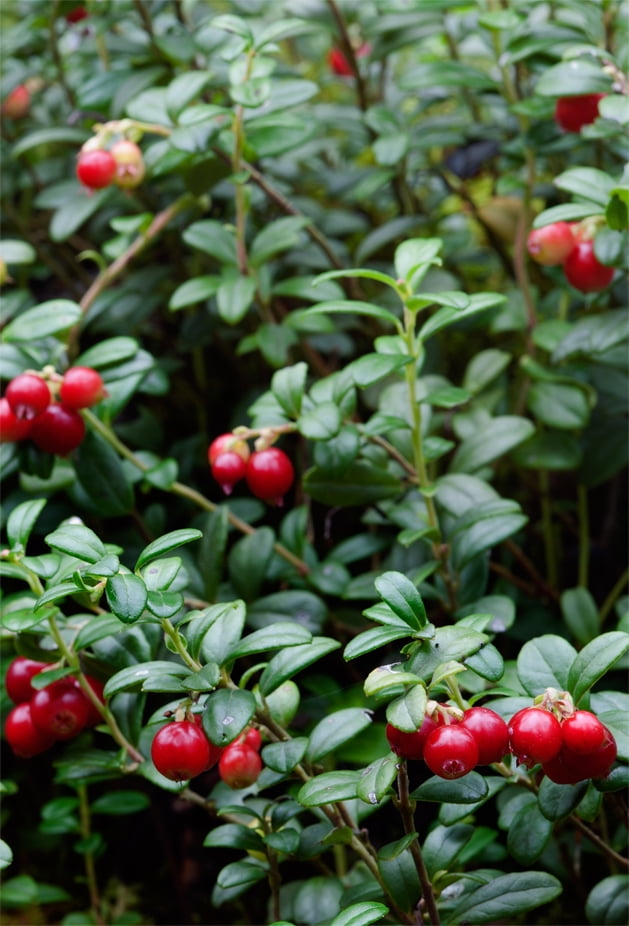
After five or six years, pruning every two or three years will encourage dense shoot growth and increased fruit production.

Other than spot weeding and watering in dry spells (plants need 1 inch of water per week) and clipping broken or dead branches, lingonberries need little maintenance. Yields from mulched plants can be as much as four times those of unmulched ones. As plants grow in height, add more mulch. Mulch plants right after planting with 2 to 3 inches of peat moss or sawdust. They can also be grown in containers, such as half whiskey barrels, although they must be overwintered in a mulched trench or banked with hay bales to avoid severe heaving and winter damage. Lingonberries make an attractive ground cover under azaleas and rhododendrons. In a few years the plants will fill in the space, creating a low, evergreen hedge. Space plants 14 to 18 inches apart in rows 3 to 4 feet apart. Set plants at the same height that they were growing. Holes need to be a few inches deeper than the rootball or the height of the pot, and wide enough to accommodate the spreading roots. To ensure easy adjustment to transplanting, choose plants that are at least 2 inches high, preferably in 1-gallon pots. Wait until all danger of frost has passed before setting out your new plants. Plants benefit from magnesium if soil tests indicate low levels. If not, add a low nitrogen organic fertilizer (5-10-10) or compost. If your plants produce several inches of new growth each year, they do not need to be fed. Too much nitrogen results in excessive growth into late fall, then plant dieback, and reduced cropping.
Lingonberry plants near me full#
Plan on a full year of advance preparation of your plot with weed-smothering, soil building cover crops. Plants must be set out in a weed-free environment. Shallow roots also mean that lingonberries do not compete well with weeds. Although the plant does not need the boggy conditions of the cranberry, the roots are shallow and need a consistent moisture supply. To accomplish this, I turned 7 pounds of pre-moistened peat moss into 100 square feet of soil. They need well drained soils that are rich in organic matter. Lingonberries are slow to establish, taking four to seven years to mature, and they compete poorly with other plants. The pH need to be below 5.8, with the ideal being 5.0.

Lingonberries do not do well in excessively hot, droughty conditions. As with any fruit bearing crop, sunnier sites encourage larger crops. Lingonberries grow well in full sun or partial shade, making them an ideal understory plant for such other acid loving plants as highbush blueberries. It does need protection from drying winds in open winters.


The acid-loving plant grows best in a cool climate and is hardy to at least 30 below zero with snow cover. Mature plants reach 12 to 18 inches in height and spread up to 18 inches. Branches sprout from both underground runners and the plant base. The lingonberry grows as a shiny leaved, short spreading, evergreen shrub, quite similar to the lowbush blueberry, although the branches of the plant are more tender and less woody. majus) have slightly larger berries and often bear two crops in one growing season. The cultivated lingonberries of European origin ( Vaccinum vitis-idaea var. This native species bears an annual crop of small red berries that are similar to cranberries in tartness and texture. minimus), usually known as the lowbush or mountain cranberry, do grow wild in the cooler regions of the United States. The next time I visited I saw their plants, and the following spring, they gave me a dozen of the trailing plants.Ī close relative of the cranberry and the blueberry, lingonberries ( Vaccinum vitis-idaea var. Having not acted quickly enough, my life was void of lingonberries – until some northern friends of Scandinavian descent gave me a jar of their lingonberry sauce. I did have to act quickly though, because supplies were limited. The ad promised bushels of berries and great fortune in no time at all, and with little labor. Until recently, the only place that I had heard about lingonberries was on the back page ad of the newspaper’s comic section.


 0 kommentar(er)
0 kommentar(er)
